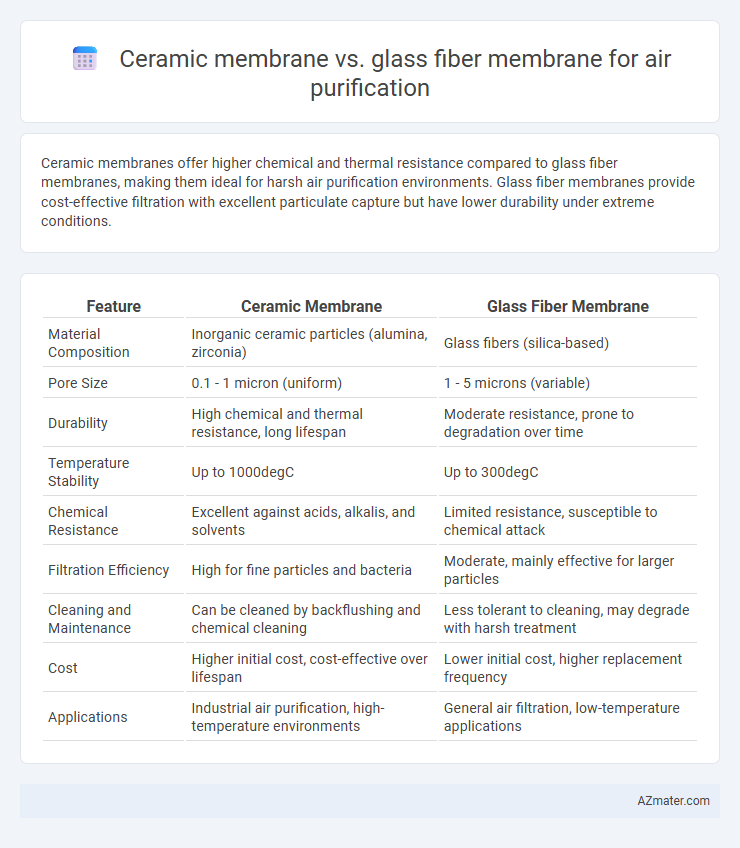Ceramic membranes offer higher chemical and thermal resistance compared to glass fiber membranes, making them ideal for harsh air purification environments. Glass fiber membranes provide cost-effective filtration with excellent particulate capture but have lower durability under extreme conditions.
Table of Comparison
| Feature | Ceramic Membrane | Glass Fiber Membrane |
|---|---|---|
| Material Composition | Inorganic ceramic particles (alumina, zirconia) | Glass fibers (silica-based) |
| Pore Size | 0.1 - 1 micron (uniform) | 1 - 5 microns (variable) |
| Durability | High chemical and thermal resistance, long lifespan | Moderate resistance, prone to degradation over time |
| Temperature Stability | Up to 1000degC | Up to 300degC |
| Chemical Resistance | Excellent against acids, alkalis, and solvents | Limited resistance, susceptible to chemical attack |
| Filtration Efficiency | High for fine particles and bacteria | Moderate, mainly effective for larger particles |
| Cleaning and Maintenance | Can be cleaned by backflushing and chemical cleaning | Less tolerant to cleaning, may degrade with harsh treatment |
| Cost | Higher initial cost, cost-effective over lifespan | Lower initial cost, higher replacement frequency |
| Applications | Industrial air purification, high-temperature environments | General air filtration, low-temperature applications |
Introduction to Air Purification Membranes
Ceramic membranes offer exceptional chemical resistance, high thermal stability, and durability, making them ideal for harsh air purification environments where long-term performance is critical. Glass fiber membranes provide a cost-effective solution with high porosity and effective particulate filtration, but they are more susceptible to moisture and chemical degradation. In air purification applications, selecting between ceramic and glass fiber membranes depends on the specific contaminants, operational temperature, and required membrane lifespan.
Overview of Ceramic Membranes
Ceramic membranes offer superior thermal stability and chemical resistance compared to glass fiber membranes, making them ideal for harsh air purification environments. Their microporous structure enables efficient filtration of fine particulate matter and contaminants at high temperatures. This durability and filtration precision position ceramic membranes as a premium solution in industrial air purification systems.
Overview of Glass Fiber Membranes
Glass fiber membranes are widely used in air purification due to their high porosity and excellent filtration efficiency for particulate matter. These membranes consist of interwoven glass fibers that provide a large surface area and durability under various environmental conditions. Their ability to capture fine dust, pollen, and other airborne particles makes them suitable for HVAC systems and industrial air filtration.
Filtration Efficiency Comparison
Ceramic membranes achieve filtration efficiencies exceeding 99.9% for particulate matter down to sub-micron sizes, outperforming glass fiber membranes that typically capture around 95-98% of similar particles. The inherent micro-porous structure of ceramic membranes enables superior removal of fine particulates and aerosols, enhancing air purification performance in industrial and environmental applications. Glass fiber membranes, while effective for general dust filtration, exhibit lower mechanical strength and pore stability, which can reduce long-term filtration efficiency compared to ceramic alternatives.
Durability and Lifespan Analysis
Ceramic membranes in air purification offer superior durability due to their resistance to high temperatures, chemical corrosion, and mechanical stress, resulting in a lifespan that often exceeds 5 years under industrial conditions. In contrast, glass fiber membranes typically have a shorter lifespan of 1 to 3 years because they are more susceptible to physical damage, clogging, and chemical degradation. The enhanced structural integrity of ceramic membranes contributes to lower maintenance costs and more consistent filtration performance over time compared to glass fiber alternatives.
Resistance to Extreme Conditions
Ceramic membranes exhibit exceptional resistance to high temperatures, corrosive gases, and abrasive particles, making them ideal for harsh industrial air purification environments. Glass fiber membranes typically degrade under extreme heat and chemical exposure, limiting their use to milder operating conditions. The superior thermal and chemical stability of ceramic membranes ensures prolonged operational life and consistent filtration performance in extreme conditions.
Maintenance and Cleaning Requirements
Ceramic membranes for air purification offer superior durability and resistance to chemical and thermal stress, enabling less frequent cleaning cycles compared to glass fiber membranes. Glass fiber membranes require regular maintenance due to their susceptibility to clogging and degradation from particulate accumulation, resulting in higher operational costs. The robust structure of ceramic membranes allows for efficient backflushing and chemical cleaning processes, significantly reducing downtime.
Cost and Economic Considerations
Ceramic membranes generally have higher initial costs compared to glass fiber membranes due to their durable material composition and specialized manufacturing process. However, ceramic membranes offer longer lifespan and better resistance to high temperatures and harsh chemicals, resulting in lower replacement frequency and maintenance costs over time. Glass fiber membranes, while more affordable upfront, may require more frequent replacements and incur higher operational expenses in industrial air purification applications.
Environmental Impact and Sustainability
Ceramic membranes exhibit superior environmental sustainability compared to glass fiber membranes due to their longer lifespan, chemical resistance, and energy-efficient regeneration processes that reduce waste generation. Glass fiber membranes, while cost-effective, often require frequent replacement and generate more non-biodegradable waste, contributing to higher environmental burdens. The recyclability and durability of ceramic membranes make them a more eco-friendly choice for air purification applications focused on minimizing environmental impact.
Application Suitability and Recommendations
Ceramic membranes offer superior chemical resistance, high-temperature tolerance, and long-term durability, making them ideal for industrial air purification applications involving harsh gases or volatile organic compounds. Glass fiber membranes provide excellent filtration efficiency and cost-effectiveness for general air filtration in HVAC systems, clean rooms, and commercial buildings where operating conditions are less extreme. For environments requiring robust performance against aggressive pollutants and high temperatures, ceramic membranes are recommended, while glass fiber membranes suit standard air quality control with lower maintenance needs.

Infographic: Ceramic membrane vs Glass fiber membrane for Air purification
 azmater.com
azmater.com